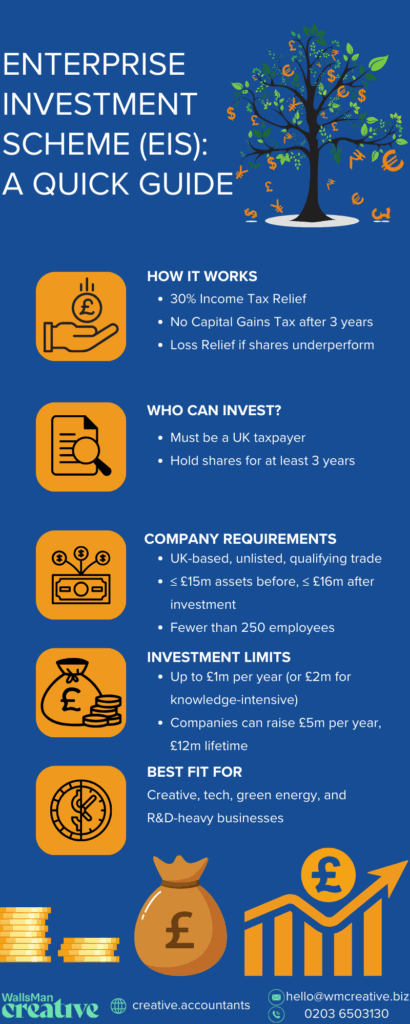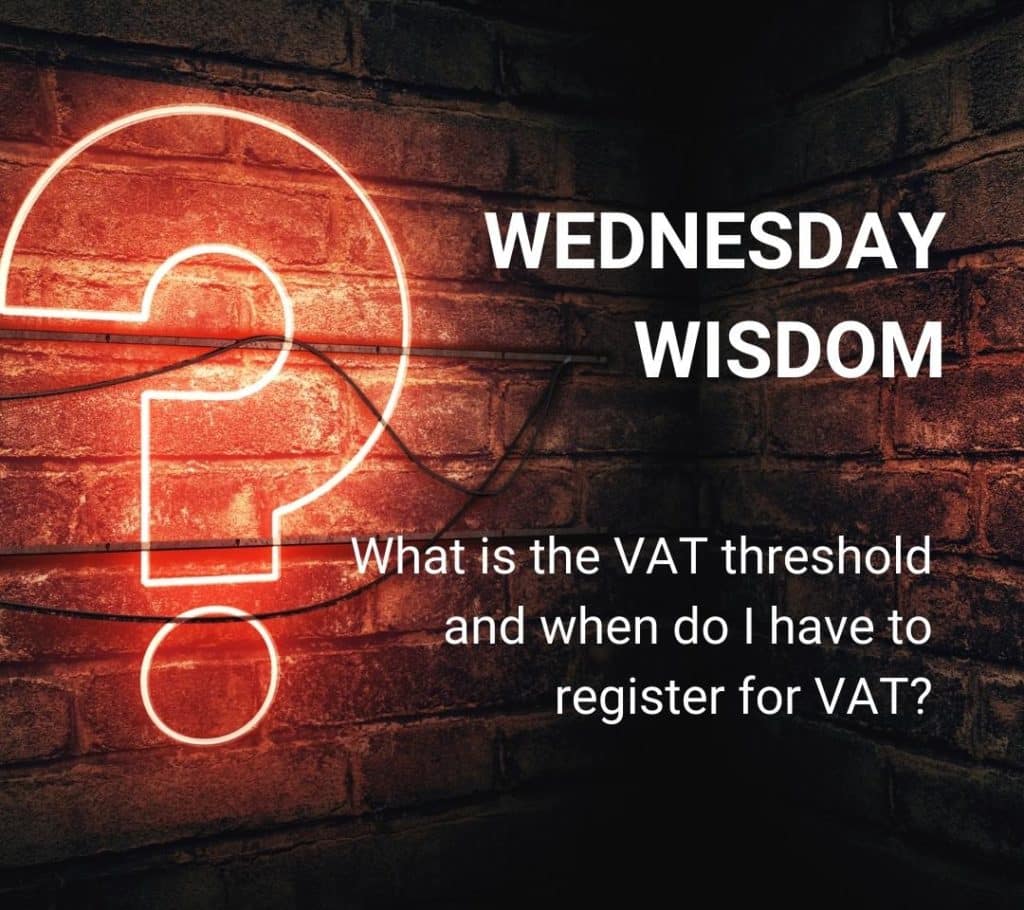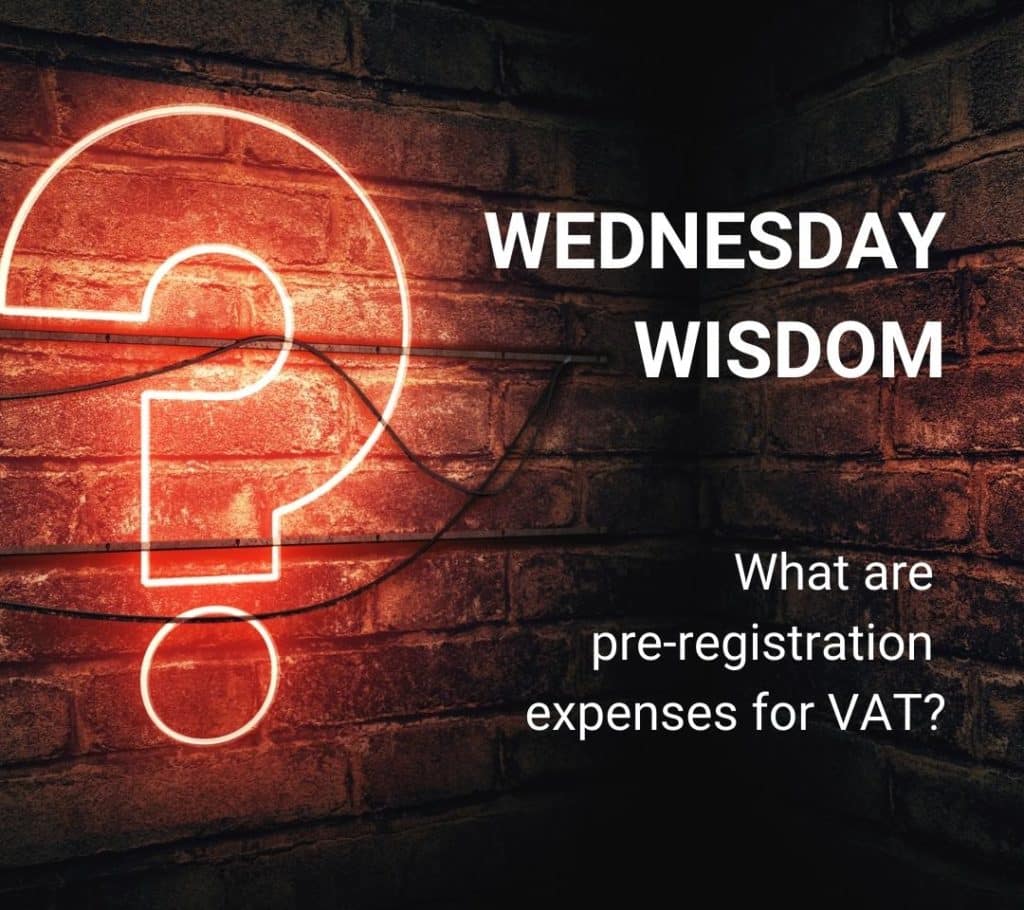The Enterprise Investment Scheme (EIS) is a government-backed initiative that encourages people to invest in early-stage UK companies by offering tax relief.
The ultimate goal is to support smaller, high-risk businesses that struggle to raise money through other traditional channels. How does the Enterprise Investment Scheme (EIS) work?
EIS gives investors a motivation: tax reliefs that reduce the risk of investing in startups.
In sectors where innovation and creativity is common, it’s pretty hard to secure funding. EIS was made just for this by the UK government. The businesses we work with (technology, green energy, film, design, gaming etc.) often have amazing ideas but lack access to capital.
For creative startups, EIS gives a clear path to funding… without relying on loans or giving up too much control. It attracts investors who are willing to support original ideas with long-term potential.
The result?
A practical route for creative businesses to grow organically with backing from people who believe in early innovation.
Creative Takeaways
- The Enterprise Investment Scheme (EIS) is a UK government initiative to encourage investment in early-stage companies through tax relief.
- EIS offers 30% income tax relief, no capital gains tax on profits, loss relief, capital gains tax deferral, and inheritance tax relief.
- Only UK taxpayers can invest – as private individuals. Investors must hold shares for at least three years and not control the company or be connected through employment.
- Eligible companies must be UK-based, unlisted, have <250 employees, and meet strict asset and trading activity rules.
- Creative businesses usually qualify, especially if they are Knowledge-Intensive Companies (KICs).
Table of contents
1. Benefits of Enterprise Investment Scheme (EIS)
The Enterprise Investment Scheme offers tax reliefs that make investing in small UK companies less risky.
For creative fields this means easier access to funding. But what are the benefits of EIS?
Investors can get a range of tax incentives, and all of these reward the long-term backing of early-stage companies. All of the benefits are made to encourage this support where it’s most needed.
Let’s see a breakdown of the key EIS tax benefits, including the well-known Enterprise Investment Scheme income tax relief:
- 30% income tax relief: Investors can claim back 30% of the amount they invest, up to £1 million per tax year. This applies if they hold the shares for at least three years. It’s a direct deduction from their income tax bill, not just a reduction in taxable income.
- No capital gains tax on profits: If investors sell their shares after three years, any profit is free from capital gains tax.
- Loss relief: If the company fails, investors can offset their loss against income or capital gains tax. This reduces their overall risk.
- Capital gains tax deferral: If an investor has a gain from another asset, they can defer paying tax on it by reinvesting that gain into an EIS-eligible company.
- Inheritance tax relief: After holding the shares for two years, they can qualify for 100% relief from inheritance tax through Business Property Relief.
Great, now you know what EIS stands for, you already know the benefits of it, but…
Are you eligible for it?
| Creative Tip If your company is in a creative or innovation-led field, you might qualify as a Knowledge-Intensive Company (KIC) under EIS. As a KIC, you can access higher investment limits and longer eligibility (up to £10M/year and 10 years since first sale). |
2. Are you eligible for EIS investment?
Not everyone can invest through the Enterprise Investment Scheme (EIS). Those who can invest in EIS, need to meet a few basic conditions.
Who can invest under EIS?
You must be a UK taxpayer to benefit from the tax reliefs.
Most individual investors qualify, but you can’t use EIS through a company or a trust. The scheme is meant to reward private investors who are putting their own money at risk.
Limits on your stake
You can’t control the company.
Your total stake – when combined with any shares held by close relatives – must be less than 30% of the company’s ordinary shares, voting rights, and rights to assets.
Keep in mind that if you go over this limit, you’ll lose the tax benefits.
Your responsibilities as an investor
To keep your tax relief:
- You must hold the shares for at least three years.
- You can’t have a connection to the company as an employee, director (in most cases), or paid consultant before the investment.
- You must buy new ordinary shares, paid in full and in cash.
Failing to meet any of these conditions could cancel your relief and lead to a repayment of tax.
HMRC has strict but clear rules. If you follow them, you can stay eligible for all EIS tax reliefs.
3. Company qualification for EIS
Just as with investors, not every business qualifies for the Enterprise Investment Scheme (EIS).

To be eligible, a company must meet several conditions set by HMRC. These rules are all in place to help the scheme stay genuine, so it supports early-stage businesses
Basic company criteria for EIS
- The company must be UK-based and carry out most of its trading in the UK.
- It must be unlisted (not on a recognised stock exchange) when the shares are issued.
- It must have fewer than 250 full-time employees.
- Its gross assets must not exceed £15 million before the investment and £16 million after.
- It must not be controlled by another company.
Age of the company
The business must issue EIS shares within 7 years of making its first commercial sale. For knowledge-intensive companies, this limit extends to 10 years – as stated earlier.
Qualifying trades for EIS
EIS is available to most sectors, but some trades are excluded!
Excluded sectors are banking, property development, legal or accountancy services and many more. You can see the full list of excluded activities on HMRC’s website.
Creative industries (film, animation, design, publishing etc.) are generally safe, as long as they’re run as trading businesses – and not purely for investment.
Meeting these rules is key to securing advance assurance from HMRC and attracting investors looking for EIS tax relief.
4. How to apply for EIS: step-by-step guide
Applying for EIS is easy, but it’s a bit different compared to SEIS. It’s a simple process where each step matters both for your company and for your investors.
Don’t worry if you’re a bit lost in it, we’re here to help. Feel free to get in contact with us!
Until then, we’ve prepared a step-by-step guide, so you can do it properly and give your backers the paperwork they need to claim tax relief.
Step 1: Apply for Advance Assurance
Send an Advance Assurance request to HMRC – learn more about it on our blog.
This is a written response confirming your company and share offer are likely to qualify for EIS. It’s not required by law, but most investors expect it before they commit funds.
Step 2: Raise funding and issue shares
Once you’ve received commitments from investors, issue the shares.
These must be new ordinary shares, paid in full and in cash. The shares can’t carry special rights to company assets or be redeemable.
Step 3: Submit EIS1 compliance statement
After the shares are issued, send the EIS1 form to HMRC.
This tells them you’ve completed the investment and are asking to issue tax certificates. They’ll review your case before giving the green light.
You can start the EIS1 compliance statement process with your government gateway account.
Step 4: Provide EIS3 Certificates
Once HMRC approves your EIS1, they’ll authorise you to issue EIS3 certificates.
These are the documents investors need to claim relief. The Enterprise Investment Scheme claim form is based on this certificate.
5. Final Thoughts from WM Creative: Is EIS Right for You?
The Enterprise Investment Scheme (EIS) gives creative businesses a practical route to funding. EIS can open the door to investors who value innovation, and get tax efficiency on top of it.
But is EIS right for you?
We have more than 10 years of experience working with creatives, and we can safely say that this investment scheme offers a way to raise money without giving up too much control.
If you’re building something with long-term potential and need the right kind of backing, EIS is worth considering.
WM Creative can help you assess your eligibility, prepare your Advance Assurance, and guide you through the full process. If you have any questions regarding this process, ask away: now is your chance!
PS. If you’re hesitant whether you have to apply for SEIS or EIS, check our dedicated EIS vs SEIS blog post.




